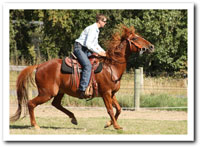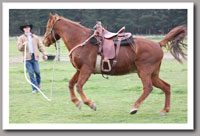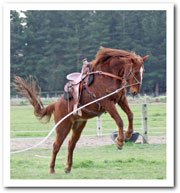When Not to Ride!
It’s a matter of heeding the signs.
How often do you hear someone say: ‘He did such and such out of the blue!!’
Believe me there are always signs that your horse is ‘not right’ and when they are not right, Do not get on!
I believe the majority of accidents happen when horses are ‘affected’ by mineral imbalances. When they are touchy, twitchy or hypersensitive they are ‘reacting’ not thinking. Sometimes they are unusually distracted and their attention is not with you, because of dietary issues described in “How Grass Affects Horses”.
An overly reactive horse is a dangerous horse, prone to violent outbursts. If they are tied up they are liable to have a sudden pull-back. If you manage to get them in the float, they are liable to have a violent outburst, end up over the front bars, out the window or rush back off before you’ve even had a chance to undo the back bar.
Excessive Spooking

Whilst it is normal for horses to look sideways or even spook at unfamiliar things an over-reactive horse is liable to do the lightening fast, all 4 feet off the ground sort of spooks that can leave you dumped in the dirt!
And maybe there wasn’t even anything to spook at! Or it was something he’d been passed yesterday no problem!
Herd-bound Behaviour
(Separation Anxiety)
It is perfectly normal for horses to want to ‘go with the herd’. They are after all, herd animals. What is not normal is when you can’t leave them on their own in the paddock without them spending the whole time you are away screaming out for their mate, tearing around, ripping up the paddock.
An excessively herd-bound horse will totally lose the plot if you try to prevent him being near his mate (who might only be a few yards away!). This includes bucking, rearing, leaping and plunging. When they are ‘beside themselves’ type herd-bound they are 100% distracted with thoughts of staying with the other horse and it is best not ride them!
Just make the changes to the diet and you will find the separation anxiety has reduced to being manageable or gone completely.
Tense, Quivery, Standoffish
Not wanting to be touched or brushed is the horse telling you not to ride.
This can be caused by inflammation of muscles or over excitability of nerve endings as in Jane’s horse ‘Amigo’.
Of course they will be touchy, grumpy and prone to doing something out of character when their bodies are inflamed like this.
If you ride them, anything could happen. An ‘affected’ horse can buck more violently than a bucking horse in a rodeo! You will think it was ‘out of the blue’ but there would have been signs well before he exploded. Maybe he was a bit touchy to girth up, maybe he didn’t want to stand still for saddling or mounting, maybe he tensed or his head went up looking behind him as you mounted, (bad sign!).
Many times I have heard: ‘but he has always been like that’. This means it was always an accident waiting to happen. Horses need to be calm and healthy to be safe to ride.
This is where Groundwork comes in. How useful to know how to check your horse out on the ground before mounting.

One of the most risky ridden moments is when you have one foot in the stirrup and your other leg is going over.
Learning groundwork teaches you how to read the signs so you won’t get caught out!
Your Gut Feelings
 If you don’t feel your horse is OK then he probably isn’t and you are best to follow your gut instinct and not ride him until you are sure he is back to normal.
If you don’t feel your horse is OK then he probably isn’t and you are best to follow your gut instinct and not ride him until you are sure he is back to normal.
If you are out riding and you start to feel unsafe, then there is no harm done by getting off.
Contrary to popular belief the horse will not ‘think he has won’!! What you don’t want to happen is for you to fall off or worse, be chucked off as you risk being hurt. NOT worth it!
I could fill this website with stories of all levels of riders who have had nasty accidents because they mistakenly thought they could ‘ride through it’!
You should be able to enjoy riding your horse.
I have found from my Horsemanship Instructing career that many people do not enjoy riding because their horse does scary things and this is because they are affected by the grass.
A normally functioning horse is a lot harder to upset than an affected one.
So, Why Groundwork You Ask?
There are fantastic benefits that come from becoming proficient at the groundwork. Both for you and your horse. These skills, once learned, are with you for life. You will be so much more confident and effective with horses.
A. Groundwork gives you the opportunity to practice your feel and timing before you mount up.
B. Groundwork enables you to predict exactly how the horse will ride. There will be times when you know it just saved you from being bucked off!
C. Groundwork is the means by which you can 'unstick' the horses feet, thereby 'unsticking' his mind. You ensure he is in the 'right' frame of mind for horse-back riding!! Or whatever else you may want to do with him.
D. Groundwork is the means by which you 'prepare' your horse for his relatively confined lifestyle. It enables you to teach him how to safely negotiate gateways, go into the stall or horsefloat. It is the means by which you teach him to 'stand tied', have his legs hosed, wear a cover, have his feet picked up, be saddled, bridled, and ridden. The list would be a mile long.
So many people still just "do" these things or expect the horse to know how to do them, rather than teaching the horse how to do or accept them. If the horse isn't taught how to accept restraint first, then of course he is going to pull back when you first tie him solid. You scared him to death and brought out his need for self-preservation! The more you learn how to prepare the horse, the less trouble and wrecks you will have.
For some people groundwork becomes an end in itself. Maybe for some reason they can no longer ride and it gives them something to work on with their horse. This is great and people get their horses doing some wonderful things on the ground.
Some people groundwork their horses to death!! Boring!! And unnecessary. On the other hand the right groundwork is vital for safety reasons. Hopping on your horse before you have checked him out, is tantamount to finding out too late that you are "up the creek without the paddle". Ooooops! Splatt!!
There is such a thing as essential groundwork, necessary to prepare a horse for riding. Top horsemen do it. This is the subject of this article. You need to understand and be proficient at "unsticking'' a horses feet. The benefits achieved in affecting a change in the horses attitude or frame of mind are astronomical.
It is also how your horse assesses YOU! He knows by how you approach him in the paddock whether you understand horses or not. NOT knowing certain stuff puts you on the back foot right from the start!!
You need a halter and a smooth 12' rope. Some people have an aversion to rope halters, but they definitely work best. Providing they fit right. Some are too big around the nose. Check before you hand over the dollars. The rope used in the halter has a narrow surface area and therefore the horse is less inclined to lean on it, yet it is soft and gives instant comfort upon the all important 'release'. You can be 'lighter'. The smoothness of the lead rope enables it to slide easily thru your hand, the weight of it is what gives it 'feel'.
"Unsticking the feet' is like softening or loosening the horse up. When he is 'stuck', he appears stiff, awkward, braced, often crabby, or he moves with quick, short steps. He leans on the halter and doesn't yield weightlessly in any direction. Stuck horses don't back up, they rear instead. Pam's young horse was stuck. After suggesting that he take a step backwards with a little ripple down the rope, Pam sent the curl down that lightly taps him on the nose to help him figure it out.
When your horse is truly 'halter-broke', he follows the feel on the rope so well that he 'weighs nothing'. He backs up willingly and fluidly, he laterally moves his hindquarters easily and his front end around lightly. He leads willingly, there is no 'drag' in the lead, whether you walk or trot off. He is 'with' you.
He wouldn't dream of stepping on you, being bargy, crowding or shouldering into you. That knack of putting his foot down right on top of yours just disappears.
It's all about communication. The horse needs to know what you mean! Then he is only too happy to do it. The way that you show him what you mean is by 'releasing' the pressure the nano-second he does an inkling of what you had in mind. This is called 'rewarding the try'. With practice and increased awareness you will get way better at recognizing the slightest try. So, firstly you need to have a clear picture in your mind of what you would like the horse to do. Then you have a consistent cue which starts out as subtle as you ultimately want it to be. You repeat the cue until the horse tries something. If it is the thing you had in mind, release immediately. Sooner even. If it is not the right thing, don't release, keep repeating the cue until you detect an attempt at what you are asking for. This is crucial. The horse may try several different things before he hits on the right one (the one you had in mind). Remember he doesn't know what you've got in mind. Give him time to work it out, rather than going up the phases, at this stage.
Once the horse understands what you mean by a certain cue and he's doing it but maybe not putting much effort into it, then you may escalate the cue to ask for a better response. In other words you would still start with the subtlest cue, but 'up' it and release the nano-second you detect he is putting in more effort. Your goal at this stage is to achieve one cue, one step. If you have done a good job of explaining this to him, then this is what you will get within a few days. If you are doing big cues and your horse is taking little steps, (you're doing a lot and the horse is doing a little) then you need to adjust your feel and timing.
If your horse is inclined to be impulsive, in other words you ask with a small cue and you get a lot of steps, or the horse won't 'switch off', you have several options:
- keep indicating to the horse that he doesn't need to keep moving, ie keep rubbing him until he stops. This may take awhile at first but if you keep with him, with your energy down, he will catch on.
- Raise your energy again and actually ask for more steps. By keeping the horse going (making out it was your idea) you will come to a point where you can tell he is ready to stop. Then offer for him to stop. If he doesn't stop within a few strides, raise your energy again and ask for more steps until you get the feeling he is ready to stop. The first time this may take several repetitions. Just be consistent with your cues.
It is very important to start 'correcting' this tendency to 'run off' from the ground up. They will tend to ride exactly the same way they show you on the ground. You can teach them most things on the ground first and they will comprehend you much easier under saddle. Sideways is a very good example of this, if you have got them understanding sidepassing over a pole on the ground first, it is a piece of cake to accomplish ridden. Getting them to leg yield outwards whilst they are circling is brilliant for helping them to achieve balance on a circle. Also for understanding that one leg doesn't mean go faster. You will love learning these maneuvers in lessons.
 Calm Healthy Horses
Calm Healthy Horses